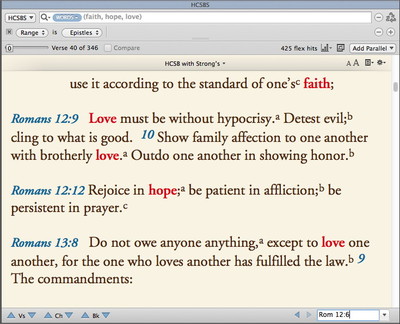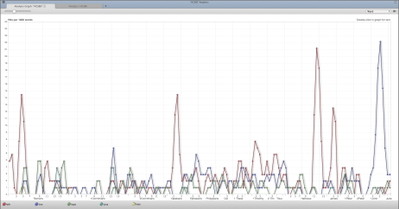In distinguishing among the authors of the New Testament epistles, someone has observed that Paul is the apostle of faith, Peter is the apostle of hope, and John is the apostle of love. Do these three authors really have such clearly discernible emphases? That’s the kind of question that can easily be explored with a simple search and the use of Accordance’s search analytics.
Using an English Bible tagged with Key Numbers (the HCSBS), I simply searched for (faith, hope, love). Enclosing a series of words separated by commas within parentheses like this is the same as using the OR command between each word. Either approach tells Accordance I want to find every occurrence of any of these three words.
Now that I have my search results, I can use Accordance’s search analytics to analyze my search results. Here’s what I get when I choose Analysis Graph from the Analytics pop-up menu. Note that I’ve chosen to graph Words rather than Key Numbers in the pop-up menu at the top right.
From this graph we can see that faith (red) is indeed a major emphasis of the apostle Paul—at least in Romans, Galatians, and the Pastoral Epistles. Yet the author of Hebrews and the apostle James focus on faith just as much as Paul does in his more faith-oriented letters. Perhaps it’s a bit misleading to call him the “apostle of faith.”
As for the epistles of Peter, 1 Peter seems to emphasize “faith” (red) and “love” (blue) with roughly the same frequency as “hope” (green). In fact, by narrowing this search to 1 Peter by itself, I found that “faith” and “hope” each appear 5 times, while “love” appears 9 times. 2 Peter mentions “faith” and “love,” but leaves out “hope” altogether. Not only does Peter not necessarily emphasize “hope,” “hope” actually appears to receive more frequent mention in the Pauline epistles of Romans and 2 Corinthians.
Where “love” is concerned, the apostle John certainly does look to deserve the title “apostle of love.” “Love” receives far more frequent mention in John’s epistles than anywhere else—even the famous “love chapter” of 1 Corinthians 13.
The value of analytics like these is that they make it easy to spot (or verify) patterns in the Biblical text. The next time you’re told that a Biblical author has a particular emphasis, put that assertion to the test using Accordance analytics.



